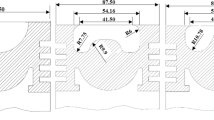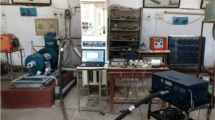Abstract
The current computational fluid dynamics (CFD) speculate reveals piston bowl geometry’s impact on an immediate base engine execution and discharge. Different bowl shapes, that is, shallow combustion chamber, hemispheric combustion chamber, and toroidal combustion chamber (TCC), were made with a reference compression ratio of 17.5:1. ANSYS V18.1 was used for numerical investigation, in tandem with the wise burning model. It was clearly identified that TCC cylinder bowl geometry delivered the proper air–fuel mixing blend inside the cylinder chamber, which prompts a homogeneous charge. Further, analytical experiments were completed to break down the TCC cylinder bowl geometry by shifting the profundity of the bowls. The case with 1.26 mm decline top to bottom of the bowl from the benchmark TCC and covered with zirconium coating gives better results. TCC produced a very powerful squish over a short period of time. TCC’s fraction of mass in carbon monoxide emissions is down to 0.03 at 25o crank angle after TDC while both hemispherical combustion chamber and shallow depth combustion chamber are measured at nearly 0.1. It was found that TCC gave a better performance compared with the other two designs at full load conditions while operating from medium to high engine speed. Overall, the low-speed application of the engine was suitable for SCC design, and TCC design was suitable for higher-speed application.




























Similar content being viewed by others

Abbreviations
- TCC:
-
Toroidal Combustion Chamber
- HCC:
-
Hemispherical Combustion Chamber
- SCC:
-
Shallow-depth Combustion Chamber
- CFD:
-
Computational Fluid Dynamics
- BTE:
-
Brake Thermal Efficiency
- BSFC:
-
Brake Specific fFuel Consumption
- NOx:
-
Oxides of Nitrogen
- CO:
-
Carbon Monoxide
- HC:
-
Hydrocarbon
- PSZ:
-
Partially Stabilized Zirconium
- FTIR:
-
Fourier Transform Infrared
- FID:
-
Flame Ionization Detector
- GCMS:
-
Gas Chromatography–mass Spectrometry
- IW:
-
Indicated Work
- TDC:
-
Top Dead Centre
- HRR:
-
Heat Release Rate
References
Kumar S, Kumar Chauhan M, Varun. Numerical modeling of compression ignition engine: a review. Renew Sustain Energy Rev [Internet]. Elsevier; 2013;19:517–30. Available from: https://doi.org/10.1016/j.rser.2012.11.043.
Diaz P. Computational optimization of internal combustion engines. Comput Optim Intern Combust Engines. 2014.
Elumalai PV, Annamalai K, Dhinesh B. Effects of thermal barrier coating on the performance, combustion and emission of DI diesel engine powered by biofuel oil–water emulsion. J Therm Anal Calorim [Internet]. Springer International Publishing; 2019;137:593–605. Available from: https://doi.org/10.1007/s10973-018-7948-6.
Perumal Venkatesan E, Kandhasamy A, Sivalingam A, Kumar AS, Ramalingam KM, Joshua P james thadhani, et al. Performance and emission reduction characteristics of cerium oxide nanoparticle-water emulsion biofuel in diesel engine with modified coated piston. Environ Sci Pollut Res. 2019;26:27362–71.
Perumal Venkatesan E, Kandhasamy A, Subramani L, Sivalingam A, Senthil KA. Experimental investigation on lemongrass oil water emulsion in low heat rejection direct ignition diesel engine. J Test Eval. 2019;47:20170357.
Parthasarathy M, Ramkumar S, Isaac JoshuaRamesh Lalvani J, Elumalai PV, Dhinesh B, Krishnamoorthy R, et al. Performance analysis of HCCI engine powered by tamanu methyl ester with various inlet air temperature and exhaust gas recirculation ratios. Fuel [Internet]. Elsevier; 2020;282:118833. Available from: https://doi.org/10.1016/j.fuel.2020.118833.
Abdul Gafoor CP, Gupta R. Numerical investigation of piston bowl geometry and swirl ratio on emission from diesel engines. Energy Convers Manag [Internet]. Elsevier Ltd; 2015;101:541–51. Available from: https://doi.org/10.1016/j.enconman.2015.06.007.
Jaichandar S, Annamalai K. Influences of re-entrant combustion chamber geometry on the performance of Pongamia biodiesel in a DI diesel engine. Energy [Internet]. Elsevier Ltd; 2012;44:633–40. Available from: https://doi.org/10.1016/j.energy.2012.05.029.
Lim J, Min K. The effects of spray angle and piston bowl shape on diesel engine soot emissions using 3-D CFD simulation. SAE Tech Pap. 2005.
Ramesh Bapu BR, Saravanakumar L, Durga Prasad B. Effects of combustion chamber geometry on combustion characteristics of a DI diesel engine fueled with calophyllum inophyllum methyl ester. J Energy Inst. [Internet]. Elsevier Ltd; 2017;90:82–100. Available from: https://doi.org/10.1016/j.joei.2015.10.004.
Fuchs TR, Rutland CJ. Intake flow effects on combustion and emissions in a diesel engine. SAE Tech Pap. 1998.
Park S. Optimization of combustion chamber geometry and engine operating conditions for compression ignition engines fueled with dimethyl ether. Fuel [Internet]. Elsevier Ltd; 2012;97:61–71. Available from: https://doi.org/10.1016/j.fuel.2012.03.004.
Béard P, Mokaddem K, Baritaud T. Measurement and modeling of the flow-field in a di diesel engine: Effects of piston bowl shape and engine speed. SAE Tech Pap. 1998.
Prasad BVVSU, Sharma CS, Anand TNC, Ravikrishna RV. High swirl-inducing piston bowls in small diesel engines for emission reduction. Appl Energy [Internet]. Elsevier Ltd; 2011;88:2355–67. Available from: https://doi.org/10.1016/j.apenergy.2010.12.068.
Payri F, Benajes J, Margot X, Gil A. CFD modeling of the in-cylinder flow in direct-injection Diesel engines. Comput Fluids. 2004;33:995–1021.
Song J, Yao C, Liu Y, Jiang Z. Investigation on flow field in simplified piston bowls for Di diesel engine. Eng Appl Comput Fluid Mech. 2008;2:354–65.
Gnana Sagaya Raj AR, Mallikarjuna JM, Ganesan V. Energy efficient piston configuration for effective air motion—a CFD study. Appl Energy [Internet]. Elsevier Ltd; 2013;102:347–54. Available from: https://doi.org/10.1016/j.apenergy.2012.07.022.
Senecal PK, Pomraning E, Richards KJ, Briggs TE, Choi CY, McDavid RM, et al. Multi-dimensional modeling of direct-injection diesel spray liquid length and flame lift-off length using cfd and parallel detailed chemistry. SAE Tech Pap. 2003.
Sivalingam A, Kandhasamy A, Senthil Kumar A, Perumal Venkatesan E, Subramani L, Ramalingam K, et al. Citrullus colocynthis—an experimental investigation with enzymatic lipase based methyl esterified biodiesel. Heat Mass Transf und Stoffuebertragung. Heat and Mass Transf. 2019;55:3613–31.
Elumalai PV., Nambiraj M, Parthasarathy M, Balasubramanian D, Hariharan V, Jayakar J. Experimental investigation to reduce environmental pollutants using biofuel nano-water emulsion in thermal barrier coated engine. Fuel. 2021;285.
Elumalai PV, Balasubramanian D, Parthasarathy M, Pradeepkumar AR, Mohamed Iqbal S, Jayakar J, et al. An experimental study on harmful pollution reduction technique in low heat rejection engine fuelled with blends of pre-heated linseed oil and nano additive. J Clean Prod [Internet]. Elsevier Ltd; 2021;283:124617. Available from: https://doi.org/10.1016/j.jclepro.2020.124617.
Jayakar J, Elumalai A, Mailainathan M, Dhinesh B, Harikrishnan G. Macroscopic characteristics of palm oil and palm oil methyl ester using dimensionless analysis. J Oil Palm Res. 2018;30:666–73.
Elumalai PV, Sivakandhan C, Parathasarathy M, Mohamad Iqubal S, Arunkumar M. Investigation on the mitigation of environmental harmful emissions by incorporating nanoparticles to biofuel water nano emulsion in low heat rejection engine. Heat Mass Transf und Stoffuebertragung. Heat and Mass Transf. 2021.
Schmidt DP, Rutland CJ. A new droplet collision algorithm. J Comput Phys. 2000;164:62–80.
Liu AB, Mather D, Reitz RD. Modeling the effects of drop drag and breakup on fuel sprays. SAE Tech Pap. 1993.
Post SL, Abraham J. Modeling the outcome of drop-drop collisions in Diesel sprays. Int J Multiph Flow. 2002;28:997–1019.
Gonzalez DMA, Lian ZW, Reitz RD. Modeling diesel engine spray vaporization and combustion. SAE Tech Pap. 1992.
Isaac Premkumar IJ, Prabhu A, Vijayan V, Godwin Antony A, Venkatesh R. Combustion analysis of biodiesel blends with different piston geometries. J Therm Anal Calorim [Internet]. Springer International Publishing; 2019; Available from: https://doi.org/10.1007/s10973-019-09144-1.
Chiang CH, Raju MS, Sirignano WA. Numerical analysis of convecting, vaporizing fuel droplet with variable properties. Int J Heat Mass Transf. 1992;35:1307–24.
Rajendran S. A comparative study of performance and emission characteristics of neat biodiesel operated diesel engine: a review. J Therm Anal Calorim [Internet]. Springer International Publishing; 2020; Available from: https://doi.org/10.1007/s10973-020-10121-2.
Subramaniam M, Solomon JM, Nadanakumar V, Anaimuthu S, Sathyamurthy R. Experimental investigation on performance, combustion and emission characteristics of DI diesel engine using algae as a biodiesel. Energy Reports [Internet]. Elsevier Ltd; 2020;6:1382–92. Available from: https://doi.org/10.1016/j.egyr.2020.05.022.
Muše A, Jurić Z, Račić N, Radica G. Modelling, performance improvement and emission reduction of large two-stroke diesel engine using multi-zone combustion model. J Therm Anal Calorim [Internet]. Springer International Publishing; 2020;141:337–50. Available from: https://doi.org/10.1007/s10973-020-09321-7.
Xue J, Grift TE, Hansen AC. Effect of biodiesel on engine performances and emissions. Renew Sustain Energy Rev [Internet]. Elsevier Ltd; 2011;15:1098–116. Available from: http://dx.doi.org/https://doi.org/10.1016/j.rser.2010.11.016.
Abdelmalek Z, Alamian R, Safdari Shadloo M, Maleki A, Karimipour A. Numerical study on the performance of a homogeneous charge compression ignition engine fueled with different blends of biodiesel. J Therm Anal Calorim [Internet]. Springer International Publishing; 2020; Available from: https://doi.org/10.1007/s10973-020-09513-1.
Abdul M, Jon HVG. The effect of biodiesel oxidation on engine performance and emissions. Biomass Bioenergy. 1998;20:213.
Namar MM, Jahanian O. Energy and exergy analysis of a hydrogen-fueled HCCI engine. J Therm Anal Calorim [Internet]. Springer International Publishing; 2019;137:205–15. Available from: https://doi.org/10.1007/s10973-018-7910-7.
He C, Ge Y, Tan J, You K, Han X, Wang J. Characteristics of polycyclic aromatic hydrocarbons emissions of diesel engine fueled with biodiesel and diesel. Fuel [Internet]. Elsevier Ltd; 2010;89:2040–6. Available from: https://doi.org/10.1016/j.fuel.2010.03.014.
Dolak J, Reitz RD. Optimization of the piston geometry of a diesel engine using a two-spray-angle nozzle. Proc Inst Mech Eng Part D J Automob Eng. 2011;225:406–21.
Jaichandar S, Senthil Kumar P, Annamalai K. Combined effect of injection timing and combustion chamber geometry on the performance of a biodiesel fueled diesel engine. Energy [Internet]. Elsevier Ltd; 2012;47:388–94. Available from: https://doi.org/10.1016/j.energy.2012.09.059.
Author information
Authors and Affiliations
Corresponding author
Additional information
Publisher's Note
Springer Nature remains neutral with regard to jurisdictional claims in published maps and institutional affiliations.
Rights and permissions
About this article
Cite this article
Sakthi Rajan, C., Muralidharan, K. Effects of partially stabilized zirconia fueled with Borassus biofuel at different piston bowl geometries in LHR engine. J Therm Anal Calorim 147, 8901–8917 (2022). https://doi.org/10.1007/s10973-021-11127-0
Received:
Accepted:
Published:
Issue Date:
DOI: https://doi.org/10.1007/s10973-021-11127-0



